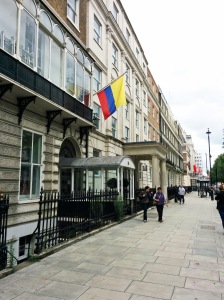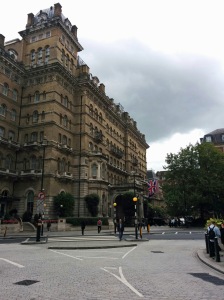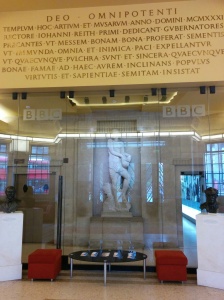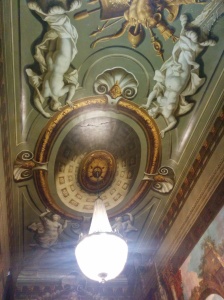Today’s Route finishes off the area to the north of Oxford Street, covering the stretch between Bond Street and Oxford Circus tube stations. Main focus is on the southern portion of Portland Place home of BBC HQ and the Langham Hotel but also foreign embassy central.
 Starting point is Bond Street tube from where we head north on Marylebone Lane then right at Wigmore Street and south again on Welbeck Street to Vere Street. Here we find St Peter’s Church once known as the Oxford Chapel. This is now the base for the London Institute of Contemporary Christianity.
Starting point is Bond Street tube from where we head north on Marylebone Lane then right at Wigmore Street and south again on Welbeck Street to Vere Street. Here we find St Peter’s Church once known as the Oxford Chapel. This is now the base for the London Institute of Contemporary Christianity.
The Brazilian Consulate General (different from the embassy) is also located here at no.3. 
Chapel Place skirts up the side of House of Fraser at no.350 Oxford Street. Up until its rebranding in 2001 this was the main branch of DH Evans. (DH Evans was named after Welshman Dan Harries Evans and opened on Oxford Street in the last century. It was quickly expanded but Mr Evans died penniless in 1928 after a series of unsuccessful property deals. House of Fraser is unfortunately not after the misanthropic Dad’s Army character though it did originate in Glasgow – in 1849 as Athur and Fraser).
 This brings us to the bottom end of Wimpole Street (see previous post). Since 1912 No.1 has been the home of the Royal Society of Medicine. Both Charles Darwin and Sigmund Freud are Honorary Fellows of the Society and five of its former presidents have diseases named after them. The symbol of the serpent entwined around a staff derives from the rod wielded by the Greek god Asclepius, a deity associated with healing and medicine.
This brings us to the bottom end of Wimpole Street (see previous post). Since 1912 No.1 has been the home of the Royal Society of Medicine. Both Charles Darwin and Sigmund Freud are Honorary Fellows of the Society and five of its former presidents have diseases named after them. The symbol of the serpent entwined around a staff derives from the rod wielded by the Greek god Asclepius, a deity associated with healing and medicine.
Somewhat ironically No.1A houses the London HQ of Coca Cola.
Further down the street we find the London Eye Hospital
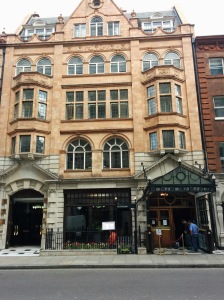 At the intersection with Wigmore Street (again) is the world-renowned Wigmore Hall London’s premier venue for chamber music. Rather shamefully I have only ever been here once which was when my A level Russian group (all three of us) came up to hear the poet Yevgeniy Yevtushenko. So that would be have been either 1976 or 1977 and I suspect none of us managed to follow a word.
At the intersection with Wigmore Street (again) is the world-renowned Wigmore Hall London’s premier venue for chamber music. Rather shamefully I have only ever been here once which was when my A level Russian group (all three of us) came up to hear the poet Yevgeniy Yevtushenko. So that would be have been either 1976 or 1977 and I suspect none of us managed to follow a word.
The stage and green room at the Wigmore Hall
This rather splendid edifice opposite the Wigmore Hall at no.33 brings us back into the realm of department stores as this is where Debenhams began. (Its genesis was actually at no.44 but it moved to no.33 in 1851 as Debenham and Freebody and properly took off from that point.)

Via Queen Anne Street we reach yet another stretch of Harley Street and here at No.43-49 is sited Queen’s College which was founded in 1848 as the first academic institution providing girls aged 11-18 with a secondary education that would allow them to go on to university.
In a flat at the very grand no.2 Mansfield Street resided the music patron and philanthropist, Sir Robert Mayer (1870 -1985), who was one of the founders of the London Philharmonic Orchestra and (as you can see) lived to be 105. When he appeared on Desert Island Discs at the age of a hundred he picked Son of My Father by Chicory Tip as his favourite track.
 This rather enigmatic grade II listed building at no. 10 Duchess Street is now part of the British Medical Association and originates from around 1770 as designed by Robert Ada. At the end of the 18th century the house was acquired by Thomas Hope, a wealthy Dutch designer and collector. His remodelling of the interior based on a series of themes included an Egyptian Room but whether this was inspired by or led to the creation of the sphinxes on the exterior is unclear.
This rather enigmatic grade II listed building at no. 10 Duchess Street is now part of the British Medical Association and originates from around 1770 as designed by Robert Ada. At the end of the 18th century the house was acquired by Thomas Hope, a wealthy Dutch designer and collector. His remodelling of the interior based on a series of themes included an Egyptian Room but whether this was inspired by or led to the creation of the sphinxes on the exterior is unclear.
Back out now on to the lower end of Portland Place with its cluster of embassies. So high numbers to low we have China down at no. 49, Poland a non-mover at no. 47, Kenya bubbling under at no. 45, Columbia a new entry at no.35, Sweden climbing to no.27 and Portugal smashing in at no.3.
Adjacent to Portugal on the eponymous Langham Street lies the Langham Hotel opened in 1865 and mooted as the first of Europe’s so-called “Grand Hotels”. It was built at a cost of £300,000 which today would get you about 12 nights in the penthouse Sterling Suite.
Notwithstanding that the most famous occupant of Portland Place is of course the good old BBC Broadcasting House. W1A 1AA being possibly the most iconic post code in the country – at least for those of us old enough to have written actual letters to BBC television programmes. Built in classic art deco style in 1932 the building was extensively restored and redeveloped in the early years of the 21st Century and as well as being the administrative HQ of the BBC is home to its news and radio services.
The statues on the exterior of the building are the work of the supremely talented but infamous Eric Gill (1882 – 1940). Suffice to say, were Eric Gill alive today his activities would be of more than passing interest to Operation Yewtree. There are probably few more prominent examples of the vexed question of whether or not it is possible to continue to admire the work of an artist whose personal mores turn out to be abhorrent.
Round the back of the new development (on Middleton Place) is the home of Radio 1 and Radio 1-Xtra. And on this day there was a posse of young hopefuls looking out for the visiting James Bay, one of the new breed of sensitive male singer-songwriters (Ed Sheeran you have a lot to answer for). At another entrance (presumably Radio 6) was a collection of trainspottery middle-aged men clutching record bags but I never did find out who they were hoping to meet.
Just next door to the BBC on is All Souls, the last remaining church designed by John Nash (1752 – 1835), which opened in 1824.
Not to be confused of course with either the mathematician John Nash who was the subject of “A Beautiful Mind” or the pop reggae singer Johnny Nash of ” I Can See Clearly” fame.
East of here the walk takes in the man stretch of Langham Street where the attractively tiled Grange Langham Court makes a bit of a show of itself before moving on to Hallam Street, Gildea Street, Girfield Street and a bit more of Great Portland Street without arousing further interest before heading back via Riding House Street where another embassy, that of Algeria, sits at No.1 (with a bullet).
This is the point where Portland Place merges into Regent Street (north) but we head straight across and on to Cavendish Place. Chandos Street to the north is home at no.11 to the Medical Society of London founded in 1773. No.10a next door is built in the same style and although just offices of a financial company makes a nicer picture.
A little way further along, the entrance to Deans Mews is framed by this arch with its “levitating” sculpture of the Madonna and Child. This, the work of sculptor Jacob Epstein, was constructed from lead that was salvaged from the nearby roof of a building bombed in the Second World War and weighs in the region of three tons.
Almost final stop on this journey is Cavendish Square named after Henrietta Cavendish-Holles, the wife of the second Earl of Oxford. The statue on the centre of the square, ignored by the lunching office workers, is a recent art project which has recreated in soap the original statue of the Duke of Cumberland which stood on the plinth from 1770 to 1868 but was removed in the late nineteenth century due to posthumous disapproval of the Duke’s actions during the Battle of Culloden.
 The bronze statue on the south side of the square is of Lord William George Frederick Cavendish-Scott-Bentinck (1802 – 1848). Bentinck was a conservative MP best known for his part in the corn laws-related downfall of Sir Robert Peel and also a prominent racehorse owner and notorious gambler. He died, unmarried, aged 46 of a suspected heart attack and was buried in (our old friend) St Marylebone Parish Church.
The bronze statue on the south side of the square is of Lord William George Frederick Cavendish-Scott-Bentinck (1802 – 1848). Bentinck was a conservative MP best known for his part in the corn laws-related downfall of Sir Robert Peel and also a prominent racehorse owner and notorious gambler. He died, unmarried, aged 46 of a suspected heart attack and was buried in (our old friend) St Marylebone Parish Church.
 On the west side of the square is found The Royal College of Nursing, at no.20 which was at one time the home of Herbert Henry Asquith, Prime Minister from 1908 to 1916. The RCN, which was founded in 1916, took over the house that same year when Asquith left office and found he could no longer afford its upkeep.
On the west side of the square is found The Royal College of Nursing, at no.20 which was at one time the home of Herbert Henry Asquith, Prime Minister from 1908 to 1916. The RCN, which was founded in 1916, took over the house that same year when Asquith left office and found he could no longer afford its upkeep.
Asquith was married twice but during his term in office he also developed a romantic obsession with Venetia Stanley who went on to marry Edwin Montagu, a Liberal Cabinet Minister. He sent her over 560 letters and Churchill who was at the time the First Lord of the Admiralty, viewed this endless letter writing as “England’s greatest security risk”. However within days of his rejection by Venetia, Asquith started an intense relationship with her older sister Sylvia, which lasted for several years.
Returning to the building itself its most prominent feature is the extensive mural painted alongside and above the main staircase depicting scenes of ancient Rome. The mural is believed to date from around 1730 and be the work of Sir James Thornhill, father-in-law of Hogarth.
We end again back on Oxford Street emerging by John Lewis at no. 300. The original John Lewis store in Oxford Street was bombed to the ground during the Blitz (though amazingly without any casualties). It took until 1960 before the present building was completed and opened. The iconic Winged Figure statue by Barbara Hepworth was unveiled in 1963, John Lewis having commissioned the Yorkshire-born artist to create a work that evoked common interest and ownership.








